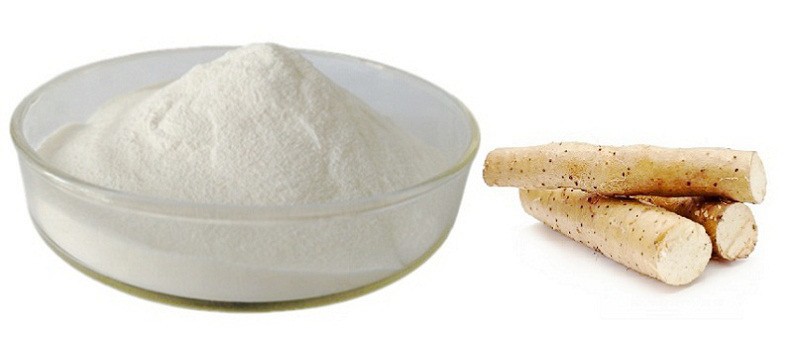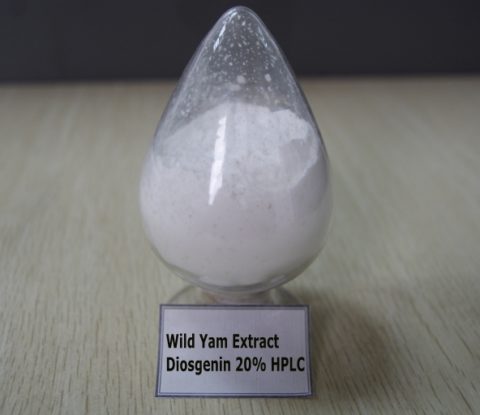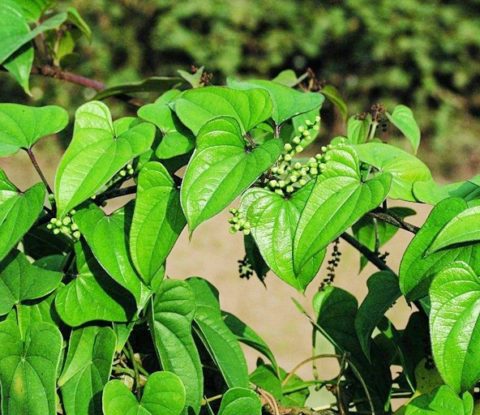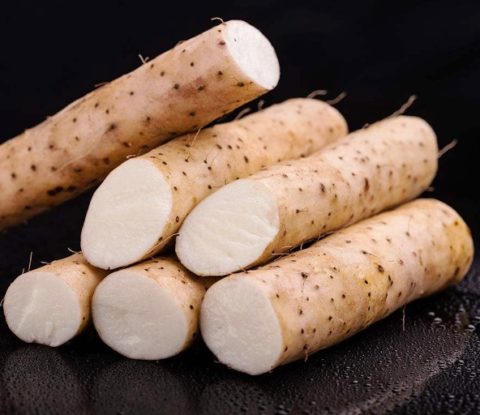
Wild Yam Extract Powder; Diosgenin 10%, 20%, 50%, 98% HPLC, 10:1, 20:1TLC
【Latin Name】: Dioscorea villosa L.
【Plant part used】: Roots (or tubers)
【Specification】: Diosgenin 10%, 20%, 50%, 98% HPLC; 10:1, 20:1TLC
【Cas No】: 512-04-9(Diosgenin)
【Test Method】: HPLC/TLC
【Particle Size】: 98% pass 80 mesh size
【Appearance】: Offwhite to white fine powder
【Main Function】: Estrogenic activity, Reduce the level of serum cholesterol
【Storage】: Store in cool dry place and keep from direct light
【Shelf life】: 2 years when properly stored
【Packing】: Fiber drum (25kg/drum); aluminum foil bag and carton box(less than 10kg)

Wild yam extract:The use of wild yam in cultural and traditional settings may differ from concepts accepted by current Western medicine. When considering the use of herbal supplements, consultation with a primary health care professional is advisable. Additionally, consultation with a practitioner trained in the uses of herbal/health supplements may be beneficial, and coordination of treatment among all health care providers involved may be advantageous. Wild yam is also known as Dioscorea villosa, China root, Mexican yam, colic root, devil’s bones, rheumatism root, yuma, and rheumatism root. Wild yam has been used for menstrual cramps or pain, menopausal symptoms, rheumatic conditions, and gallbladder complaints. Wild yam is sometimes suggested as an alternative to hormone replacement therapy. While components of wild yam are chemically manufactured into the hormones progesterone or estrogen, the body is unable to use wild yam in the same way. Wild yam has not been evaluated by the FDA for safety, effectiveness, or purity. All potential risks and/or advantages of wild yam may not be known. Additionally, there are no regulated manufacturing standards in place for these compounds. There have been instances where herbal/health supplements have been sold which were contaminated with toxic metals or other drugs. Herbal/health supplements should be purchased from a reliable source to minimize the risk of contamination.
Chemical Composition
Diosgenin is commonly seen as the active ingredient and is an aglycone.
Dioscin (Diosgenin glycone) and other glycones of Diosgenin including Dioscin Prosapogenin A, Deltonin, and Diosgenin 3-O-{a-L-rhamnopyranosyl(1fi2)}-{b-D-glucopyranosyl(1fi3)-b-D-glucopyranosyl(1fi4)}-b-D-glucopyranoside.
Zingiberensis saponin I
Diarylheptanoid compounds
Parvifloside (and Methyl Parvifloside) and two other furostanols, methyl-protodeltonin and trigofoenoside A-1
Main component appears to be Diosgenin, and a variety of molecules which are Diosgenin bound to different glycosides; other steroidal saponins appeared to exist in this species of Yam
Indications in Traditional Chinese Medicine
1. Spleen qi deficiency syndromes
It is indicated for poor appetite with loose stool, diarrhea due to spleen qi deficiency, especially for both spleen qi and yin deficiency, or needing tonifying but failure in transportation of spleen due to weakness after illness, because it can tonify both qi and yin of spleen, and it is astringent in property. For dual usage of food and medicine, neither dry nor greasy in property, it is applied singly, or taken as food for long term. For serious cases of qi deficiency, it is commonly combined with qi and spleen tonics, because it is mild in action. For instance, it is used with Ren Shen and Bai Zhu in Shen Ling Bai Zhu San from Tai Ping Hui Min He Ji Ju Fang for poor appetite with loose stool, and in Wan Dai Tang from Fu Qing Zhu Nv Ke for leukorrhagia due to down-pour of damp-turbid caused by spleen deficiency and failure in transportation.
2.Lung qi deficiency syndromes
It can tonify both qi and yin of lung directly, and tonify metal (lung) through tonify earth (spleen). For cough with little sputum or no sputum, shortness of breath, and spontaneous sweating due to lung qi and yin deficiency, it is commonly combined with herbs of tonifying qi, nourishing yin, moistening lung, relieving cough. For instance, it is used with Dang Shen, Mai Dong and Bai He. It is indicated for cough and dyspnea due to qi and yin deficiency of lung and kidney, because it can tonify qi, and nourish lung and kidney. It is usually combined with herbs of tonifying kidney, astringing lung, receiving qi and relieving dyspnea. For instance, it is used with Shu Di Huang, Shan Zhu Yu and Wu Wei Zi in Qi Wei Du Qi Wan from Zhang Shi Yi Tong (Zhang’s Medical Experience Collection).
3.Kidney deficiency syndromes
It is indicated for deficiency of yin, yang and essential qi of kidney, because it can tonify kidney qi and yin, and also has the action of astringing. It is occurred in many famous formula of kidney tonifying and combined with kidney tonics and astringents. It is indicated for soreness and weakness of lumbar and knees, frequent urination, enuresis, seminal emission, premature ejaculation, leukorrhagia in thin quality due to kidney qi deficiency, emaciated, soreness and limpness of lumbar and knees, seminal emission due to kidney yin deficiency, for instance, it is used in Liu Wei Di Huang Wan from Xiao Er Yao Zheng Zhi Jue, which is famous for tonifying kidney yin, and in Shen Qi Wan from Jin Kui Yao Lue, which is famous for tonifying kidney yang.
4. For diabetes due to both qi and yin deficiency
It is indicated for diabetes due to both qi and yin deficiency, because it can tonify both qi of spleen, lung and kidney, and yin of spleen, lung and kidney. For diabetes in slight degree, it is decocted singly and taken instead of tea. For diabetes in serious degree, it is combined with herbs of tonifying qi, nourishing yin, clearing heat, producing fluid. For instance, it is used with Huang Qi, Tian Hua Fen and Zhi Mu in Yu Ye Tang from Yi Xue Zhong Zhong Can Xi Lu.
Benefits of Wild Yam
Wild Yam Soothes Painful Cramping/Spasm: Wild Yam has a wonderful action on smooth muscle tissue, reducing muscle spasm of the uterus, fallopian tubes and ovaries, aiding in painful menstruation (dysmennorhea) and chronic pelvic pain. Wild Yam helps the uterus to work more efficiently during menses. This uterine support allows for proper function of the uterus while working to prevent uterine cramping or spasm. This herb has a wonderful action on the ovaries, toning them and aiding in ovarian cyst pain. Wild Yam is often used to treat urinary tract infection pain as well.
Pain Reduction from Pelvic Surgery: Wild Yam has been found to be effective at reducing pain, especially nerve pain from any kind of pelvic surgery. Endometriosis, ovarian cyst, uterine fibroid removal, or cesarean section.
Threatened Miscarriage: Traditionally used to treat irritable uterus and threatened miscarriage with uterine contractions present. Often combined with Cramp bark or Black Haw.
Dysfunctional and Painful Labor: Skilled midwives use this herb to regulate uterine contractions, or to aid women with pain reduction in labor. Pain is reduced by promoting proper function of the uterine muscles, soothing smooth muscles, reducing incidence of cramping up.
Afterbirth Pain: This antispasmodic action also reduces afterbirth pains postnatally, relaxing and reducing uterine cramping. Wild Yam is often combined with Motherwort for this type of pain.
Wild Yam Brings Relief for Nausea and Vomiting in Pregnancy: Wild Yam has also been used traditionally for hundreds of years, even by Native Americans, for nausea and vomiting in pregnancy (NVP) and hyperemesis gravidarum. Hyperemesis gravidarum is extreme nausea and vomiting in pregnancy.








